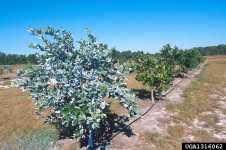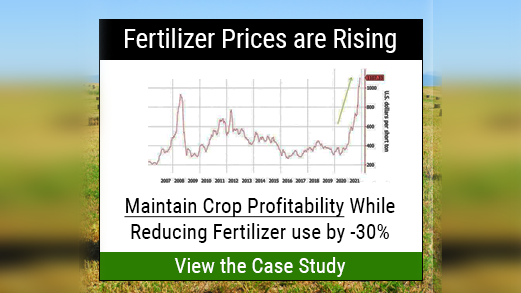Citrus Institute Takes Aim At HLB

The 2013 Florida Citrus Growers’ Institute covered a wide range of topics as attendees gathered to learn about the latest research on HLB, psyllid control, and other production-oriented subjects.
One of the most talked about stories this season has been the dramatic fruit drop experienced in citrus groves across the state. Dr. Gene Albrigo, professor emeritus UF/IFAS, told attendees of the Institute this year marks the worst in history without a major freeze or hurricane. This year’s fruit drop is costing growers more than $140 million in losses.
“The likely process is that extra stress from some aspect of HLB is leading to ethylene production in the fruit, which triggers abscission,� said Albrigo.
Nutrient Minded
Foliar nutrition to maintain trees declining from HLB remains a topic of great interest among growers. Dr. Bob Rouse, UF/IFAS citrus horticulturist, has one of the longest running trials, studying the effects of foliar nutrition on HLB-infected trees.
He presented his data collected over the past five years for Hamlins and Valencias. “HLB trials that are run less than three or four years may not be valid, as it took four to five years to get HLB declining trees back into production,� he noted.
Rouse’s Hamlin trial started with a block that was 100% infected and in decline not producing fruit. These trees were treated with various combinations of the Maury Boyd nutritional program, but it took four seasons to fully respond. The nutritional/systemic acquired resistance (SAR) cocktail increased production each year and produced four boxes per tree in 2012.
“We have five years of data from a Valencia trial in a commercial grove starting with six-year-old trees that are now 100% infected, producing less than one box per acre,� he said. “These trees treated with various combinations of foliar nutrition have increased production each year and produced two boxes per tree in the 2012-2013 season.�
Watching Water
With HLB infection rates rapidly moving higher in most all groves, keeping irrigation water and soil pH in an acceptable range of 5.5 to 6.5 is more important than ever to improve nutrient uptake. This was the message from Dr. Kelly Morgan, UF/IFAS soil scientist. We’ve always known this, but HLB has enhanced its importance, he noted.
“The lowering of soil pH by accumulation of bicarbonates from irrigation water is tolerated by healthy trees, but it appears to reduce the health of HLB-infected citrus trees by lowering nutrient availability and uptake,� said Morgan.
He added adjusting irrigation water pH to reduce bicarbonate levels should reduce this stress on the tree. However, pH in soils with high levels of copper should be reduced below 6.0 to prevent effects of copper on roots.
Dr. Jim Graham, UF/IFAS soil microbiologist, also addressed the importance of managing irrigation water and its effects on HLB-infected trees. He said high bicarbonates in irrigation water and in the soil are detrimental to the functioning of citrus roots in nutrient uptake, especially for the most sensitive rootstocks like Swingle citrumelo and Carrizo citrange.
“HLB drastically reduces root density, so the maintenance of the health of remaining roots is more important than ever where HLB is prevalent,� he said. “Monitoring well water quality and soil pH is required to determine whether management is needed.� Graham noted that conditioning irrigation water with acid treatments and/or adjustment of pH with soil amendments may be warranted if monitoring shows problems.
Psyllid Control Critical
Psyllid management remains the lynch pin of keeping HLB in check. Growers are applying multiple applications throughout the year to keep the pest’s levels low. Dr. Michael Rogers, UF/IFAS entomologist, presented an update on comprehensive psyllid control programs during the Institute.
He emphasized the importance of neonicotinoids in providing season-long psyllid control. In order to provide protection of new tree plantings from HLB, he recommended applications of these soil-applied neonicotinoids be made every six weeks. Between applications of neonicotinoids, it is imperative that growers make foliar applications of insecticides with different modes of action in order to prevent pesticide resistance from developing.
Because the neonicotinoids’ use rate must be increased with tree size, once trees reach the 5- to 9-foot height, the label restrictions on the amount of product that can be applied per acre limits the number of applications that can be made during a growing season. With the reduced ability to protect trees once they reach this larger size, it becomes increasingly important to maintain psyllid populations at low levels, particularly at an areawide level.
Citrus health management areas (CHMAs) are a testament of growers working together to control psyllids across large geographies. The goals of this program are to coordinate the timing and mode of action of pesticides used to enhance psyllid control at the regional level and also minimize the likelihood of pesticide resistance development. The program began with seven CHMAs, and as grower interest and participation has increased, the program has expanded to a total of 38 CHMAs encompassing more than 486,000 acres of commercial citrus groves.
Brandon Page, UF/IFAS program assistant in charge of coordinating CHMAs, presented new interactive features of the program’s website
(Crec.ifas.ufl.edu/chma). The new features provide more user friendly functions and illustrate the performance of individual CHMAs on maps with psyllid scouting data and application timing.










